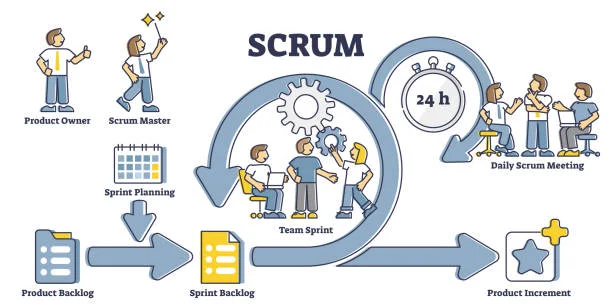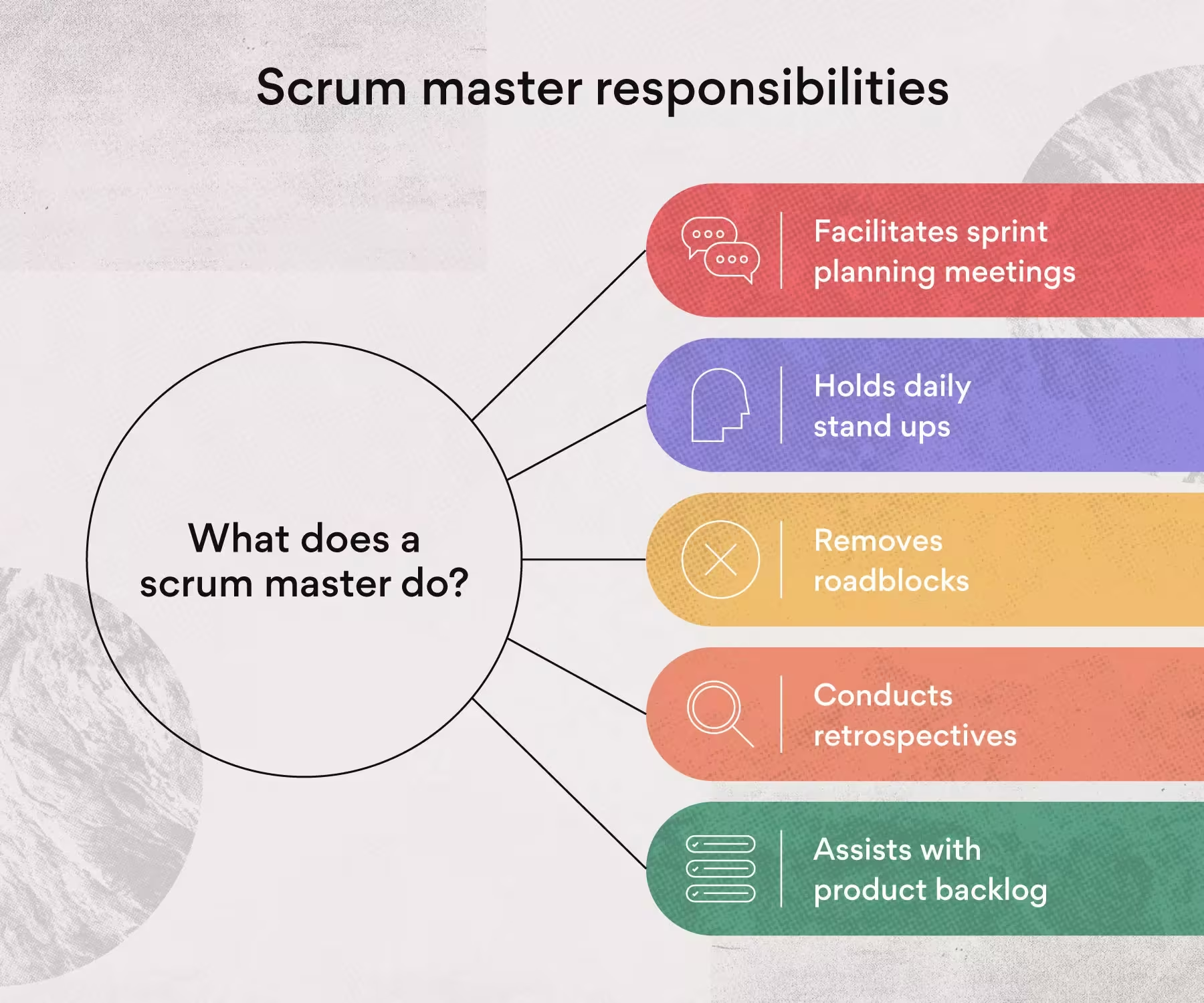In the fast-paced world of agile project management, the scrum master plays a pivotal role in ensuring teams deliver value efficiently while adhering to the principles of the scrum framework. Often described as a servant leader, the scrum master facilitates collaboration, removes obstacles, and coaches teams to embrace agile practices. This guide explores the scrum master’s role, responsibilities, and significance in agile methodology, providing actionable insights for teams and organizations looking to optimize their scrum processes.
What is a Scrum Master?
A scrum master is a facilitator and coach responsible for guiding a team through the scrum framework, a lightweight agile methodology centered on time-boxed iterations called sprints. Unlike traditional project managers, scrum masters empower teams to self-organize, focusing on process improvement and adherence to scrum principles rather than exerting control. They act as a bridge between the team and stakeholders, ensuring smooth communication and alignment with project goals.
Defining Scrum
Scrum is an agile framework that emphasizes iterative development, collaboration, and adaptability. It structures work into sprints (typically 2–4 weeks), with defined roles (scrum master, product owner, development team), artifacts (product backlog, sprint backlog), and events (sprint planning, daily standups, sprint reviews, retrospectives). The scrum master ensures these components work cohesively to deliver high-quality outcomes.
Scrum Master Role and Responsibilities
The scrum master’s primary duty is to foster an environment where the team can thrive within the scrum framework. Their responsibilities include:
- Facilitating Scrum Events:
- Daily Standups: Lead or support daily check-ins to track progress, address blockers, and align the team.
- Sprint Planning: Guide the team to define sprint goals, select backlog items, and estimate tasks while preventing over-commitment.
- Sprint Reviews: Facilitate discussions to showcase completed work and gather stakeholder feedback.
- Retrospectives: Lead sessions to reflect on what went well, what didn’t, and how to improve future sprints.
- Coaching and Mentoring:
- Educate the team on agile and scrum principles, helping them understand and apply best practices.
- Mentor team members to embrace self-organization and continuous improvement.
- Removing Impediments:
- Identify and eliminate external blockers (e.g., resource constraints) and internal roadblocks (e.g., process inefficiencies).
- Shield the team from distractions to maintain focus on sprint goals.
- Board and Tool Management:
- Administer scrum boards (physical or digital, e.g., Jira) to ensure tasks are up-to-date and progress is transparent.
- Monitor metrics like burndown charts to track sprint progress and inform planning.
- Stakeholder Collaboration:
- Act as a liaison between the team and stakeholders, ensuring clear communication of priorities and progress.
- Conduct one-on-one meetings when needed to resolve conflicts or align expectations, especially for new teams.
- Promoting Team Ownership:
- Encourage the team to take collective responsibility for the scrum process, fostering a culture of shared accountability.
- Support team morale by addressing practical needs, from fixing tools to creating a comfortable work environment.

Key Skills for a Scrum Master
To excel, scrum masters need a blend of soft and technical skills:
- Servant Leadership: Guide without dominating, empowering the team to make decisions.
- Communication: Clearly convey goals, progress, and challenges to diverse audiences.
- Empathy: Understand team dynamics and support members through challenges.
- Problem-Solving: Swiftly address impediments to keep the team on track.
- Adaptability: Adjust to changing project needs or team dynamics.
- Facilitation: Run effective meetings and ceremonies to maximize collaboration.
- Technical Awareness: Understand technical challenges (optional but helpful, especially in development-focused teams).
- Time Management: Keep sprints and events on schedule to meet deliverables.
Scrum Master in Agile Methodology
In the broader context of agile, the scrum master is a champion of agility, ensuring the team embodies values like collaboration, transparency, and continuous improvement. Unlike other agile roles (e.g., product owner, who focuses on the “what” and “why” of the product), the scrum master focuses on the “how”—optimizing processes and workflows. They ensure the team adheres to scrum’s iterative nature while remaining flexible to adapt practices for better outcomes.
Scrum Master vs. Other Roles
- Scrum Master vs. Product Owner:
- Scrum Master: Focuses on process, facilitation, and team efficiency. They ensure the team follows scrum practices and removes obstacles.
- Product Owner: Manages the product backlog, prioritizes work, and represents stakeholder interests. They define what the team builds.
- Key Difference: The scrum master handles “how” the work is done, while the product owner defines “what” and “why.”
- Scrum Master vs. Project Manager:
- Scrum Master: Encourages self-organization and collaboration, avoiding micromanagement.
- Project Manager: Often controls milestones and directs workflows, with a more top-down approach.
- Key Difference: Scrum masters empower teams, while project managers typically exert more direct control.
When Does a Team Need a Scrum Master?
Every true scrum team requires a scrum master to ensure adherence to the framework. Without one, teams risk practicing “scrum-but”—a diluted version of scrum that lacks its full benefits. A dedicated scrum master is especially critical for:
- New teams transitioning to agile, who need guidance on scrum practices.
- Teams facing complex projects, where blockers and inefficiencies are common.
- Organizations scaling scrum across multiple teams, requiring consistent facilitation.
Experienced teams may share scrum master duties, rotating facilitation roles, but a dedicated scrum master often provides the expertise needed to navigate challenges and maintain focus on agile principles.
Organizational Benefits of a Scrum Master
A skilled scrum master drives value by:
- Enhancing Efficiency: Streamlining processes to reduce waste and accelerate delivery.
- Fostering Collaboration: Building a cohesive team environment that boosts morale and productivity.
- Ensuring Consistency: Delivering predictable, high-quality outcomes through disciplined scrum practices.
- Freeing Other Roles: Allowing product owners to focus on strategy and developers to focus on building, maximizing each role’s strengths.
Real-World Example
Consider a software development team building a customer-facing app:
- Challenge: The team struggles with scope creep during sprints and frequent stakeholder interruptions.
- Scrum Master’s Role:
- Facilitates sprint planning to set clear, achievable goals.
- Shields the team from external distractions by managing stakeholder communication.
- Uses retrospectives to identify process gaps and implement solutions, like stricter backlog prioritization.
- Outcome: The team delivers sprints on time, with improved morale and stakeholder satisfaction.
Conclusion
The scrum master is the heartbeat of a scrum team, guiding it through the agile process with a focus on collaboration, efficiency, and continuous improvement. By mastering facilitation, coaching, and problem-solving, scrum masters enable teams to deliver value consistently while embracing the spirit of agile methodology. Whether you’re new to scrum or scaling it across an organization, a dedicated scrum master is key to unlocking the framework’s full potential.



